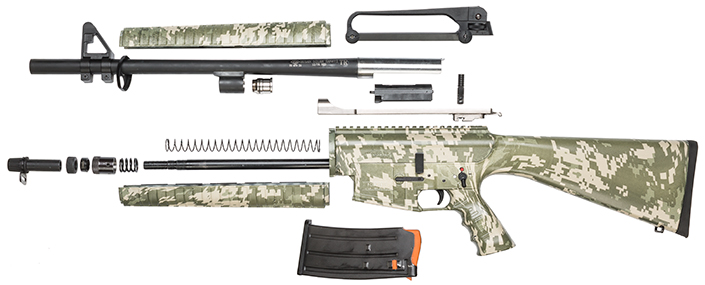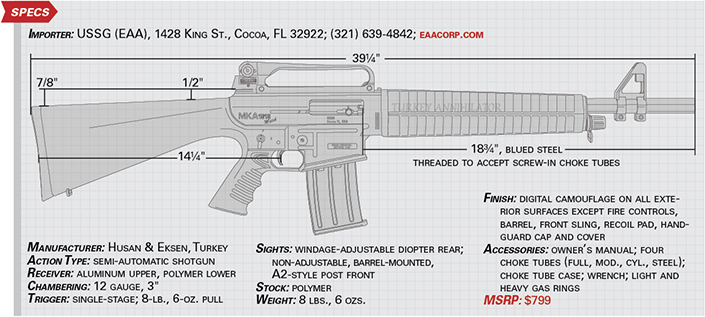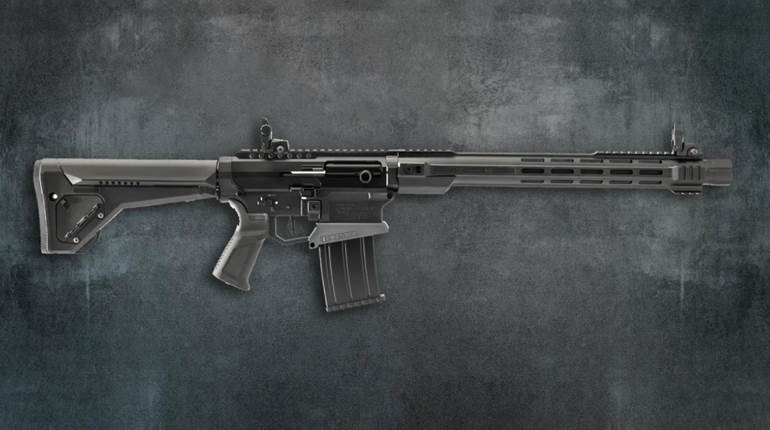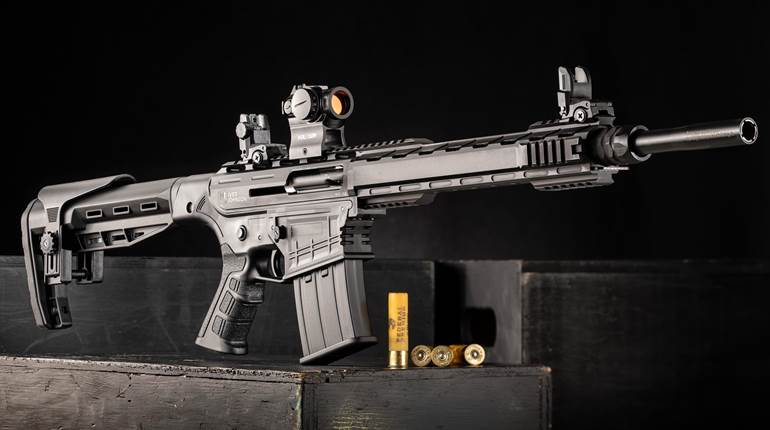
Familiarity of operation between firearms gives the user an undeniable edge in any shooting situation, be it hunting, competition or personal protection. For owners of AR-style rifles looking to diversify their arms collection with a shotgun, especially for hunting, the natural choice may be the MKA 1919 Match Turkey Annihilator.
Manufactured in Konya, Turkey, by Husan & Eksen and imported by USSG (EAA Corp.) of Cocoa, Fla., the MKA 1919 semi-automatic shotgun mimics the appearance, handling and operation (i.e. fire controls) of the AR-15. For the modern rifle shooter, this enables seamless transitioning from rifle to shotgun—retraining is minimal. And, in the hunting or competition field, there’s no hesitation or time lost due to unfamiliarity.
As with the AR platform, the MKA 1919 Match has separate upper and lower receivers, though separating them requires additional steps. Molded integral to the polymer lower is the buttstock, pistol grip and magazine well. A thick, yet relatively fragile, digital camouflage coating is applied to all but the fire controls and the 3/8"-thick rubber recoil pad. Concerning the fire controls, there’s an oversize magazine release and bolt catch, and the safety is bilateral in design. On the right side of the receiver the safe and fire positions are denoted by “S” and “F,” respectively; however, on the receiver’s left side there are only white and red plastic inserts designating such. Unlike an AR safety, there’s no positive “click” indicating each position, and nearing “fire” the hammer will fall if the trigger is pulled. Due caution is required.

On the sample gun, the single-stage trigger broke at 8 lbs., 6 ozs., with no discernible take-up or overtravel. Trigger reset, however, was both overly long and loud. Transitioning the 2¾" and 3" shells from the steel, detachable box magazines to the chamber is a floating, steel feed ramp. Accompanying the Turkey Annihilator are a two- and five-round-capacity magazine, with the former enabling the pursuit of game such as waterfowl. The magazines have bright orange polymer followers and black plastic baseplates. The bolt locks open after the last round is fired.
Machined from aluminum, the upper receiver features an integral Picatinny rail. And, as with the lower receiver and handguard, the upper has a digital camouflage finish. For sighting, the MKA 1919 Match Turkey Annihilator comes equipped with a plastic/aluminum carry handle with an integrated, windage-adjustable diopter sight with notch and peep inserts. The front sight is a non-adjustable, barrel-mounted, A2-style post. Both are easy to remove and replace should another sighting option be desired. Unlike an AR, the MKA 1919’s charging handle isn’t located at the top-rear of the upper receiver, instead, it projects outward from the bolt, as is common on most of today’s semi-automatic shotguns.
Removing the two-piece handguard permits access to the gas system—all contained on the op-rod—for cleaning and maintenance. Disassembling the operating system reveals that the shotgun, though touted as being self-adjusting, isn’t exactly so. After unscrewing the gas regulator contra nut, the gas regulator nut can then be removed. Beneath it is the gas-adjustment spring, and, under that, the gas regulator ring. The shotgun comes factory-equipped with the “Light Loads” regulator ring, which is designed to handle any 2¾" field and target loads. According to the manual, shooting magnum 2¾" or all 3" loads through the MKA 1919 Match with the “Light Loads” (black) regulator ring in place will damage the gun and/or cause injury to the user. A second, “Heavy Loads” (silver) ring is supplied for typical magnum and all 3" loads. Continuing rearward is the gas piston, bolt carrier and recoil spring. Unlike the AR, the MKA 1919 Match doesn’t have a buffer tube assembly. The bolt, which has a single extractor at the 3 o’clock position, works in conjunction with a fixed ejector on the barrel extension to remove shells. Appearance- and feature-wise, the bolt resembles that of the Remington Model 870.
When measured from the extension to the muzzle, the chrome-lined barrel is 23 13⁄16" in length; however, the barrel projects only 1 8¾" from the front of the receiver, limiting the gun’s overall length to 39¼". Two flats are milled into the receiver to provide a solid mounting surface for the A2-style sight. The barrel is threaded to accept choke tubes and ships with three flush-fitting versions: full, modified and cylinder. There was also an unmarked, extended tube, which we assumed was a turkey choke—remember, it’s the Turkey Annihilator—but its constriction (0.702") was less than the full 0.688". According to the company, its intended use is for steel shot. The full choke was used for patterning.
Given its name, it made sense to pattern the MKA 1919 Match using turkey loads. For the task we selected Remington’s 3", 1 7⁄8-oz. No. 5 Nitro Turkey loads. For testing, we opted to replace the factory iron sights with a trusted reflex-style optic, Leupold’s DeltaPoint. The results are shown in the table nearby. Suffice it to say that, at 40 yds., no gobbler would be safe from the Turkey Annihilator.
 With patterning complete, we then function-fired the MKA 1919 Match using Hornady Varmint Express 2¾", No. 4 buckshot and, after swapping gas regulator rings, Federal Premium’s 2¾" Steel Game & Target loads, which featured 1 oz. of No. 6 steel shot. We also threw into the mix a hodgepodge of 12-ga. remnants from previous testing. The manual suggests firing three to four boxes of ammunition to break in the shotgun. Other than two failures of the bolt to lock open on an empty magazine, the gun functioned without issue. We were pleasantly surprised with the MKA 1919’s ability to digest a variety of ammunition, from speedy target loads and threat-stopping buckshot to gobbler-grounding behemoths. Then again, the MKA 1919 is currently fielded by the Turkish army, so perhaps the reliable functioning should have been expected.
With patterning complete, we then function-fired the MKA 1919 Match using Hornady Varmint Express 2¾", No. 4 buckshot and, after swapping gas regulator rings, Federal Premium’s 2¾" Steel Game & Target loads, which featured 1 oz. of No. 6 steel shot. We also threw into the mix a hodgepodge of 12-ga. remnants from previous testing. The manual suggests firing three to four boxes of ammunition to break in the shotgun. Other than two failures of the bolt to lock open on an empty magazine, the gun functioned without issue. We were pleasantly surprised with the MKA 1919’s ability to digest a variety of ammunition, from speedy target loads and threat-stopping buckshot to gobbler-grounding behemoths. Then again, the MKA 1919 is currently fielded by the Turkish army, so perhaps the reliable functioning should have been expected.
As a gas-operated shotgun, naturally it’s dirtier after firing than guns featuring recoil-operated actions. That being said, the tradeoff of not needing to have a recoil spring housed in the buttstock cannot be underestimated. Moreover, the stiff recoil spring and gas operation contributed greatly to recoil reduction; even 3" turkey loads weren’t unpleasant to fire in volume.
Having thoroughly examined and tested the MKA 1919 Match Turkey Annihilator, we do have some recommendations. Foremost, it cannot be overstated that the safety needs distinct “safe” and “fire” settings. Second, a flared magazine well, which is commonplace to ARs today, would speed reloads. Lastly, the finish and sights leave much to be desired; the former flakes off easily and the latter are, for lack of a better word, cheap. Fortunately, the sights are easily removed and diehard hunters will do so.
The reality is that, despite the aforementioned issues, the MKA 1919 Match Turkey Annihilator is still a good choice for AR enthusiasts looking for a shotgun with the same fit, feel and function as their favorite arm. It’ll do the majority of what other purpose-driven scatterguns can do, but benefits from the ability to utilize box magazines.







































